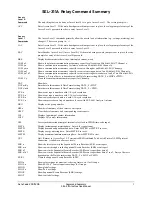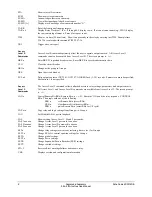
Date Code 20011205
Unsolicited Fast SER Protocol
I-1
SEL-311A Instruction Manual
APPENDIX I:
UNSOLICITED FAST SER PROTOCOL
I
NTRODUCTION
This appendix describes special binary Sequential Events Recorder (Fast SER) messages that are
not included in
Section 10: Serial Port Communications and Commands
of the instruction
manual. Devices with embedded processing capability can use these messages to enable and
accept unsolicited Fast SER messages from the SEL-311A Relay.
SEL relays and communications processors have two separate data streams that share the same
serial port. The normal serial interface consists of ASCII character commands and reports that
are intelligible to people using a terminal or terminal emulation package. The binary data
streams can interrupt the ASCII data stream to obtain information, and then allow the ASCII data
stream to continue. This mechanism allows a single communications channel to be used for
ASCII communications (e.g., transmission of a long event report) interleaved with short bursts of
binary data to support fast acquisition of metering or SER data. To exploit this feature, the
device connected to the other end of the link requires software that uses the separate data
streams. The binary commands and ASCII commands can also be accessed by a device that does
not interleave the data streams.
M
AKE
S
EQUENTIAL
E
VENTS
R
ECORDER
(SER) S
ETTINGS
W
ITH
C
ARE
The relay triggers a row in the Sequential Events Recorder (SER) event report for any change of
state in any one of the elements listed in the SER1, SER2, or SER3 trigger settings. Nonvolatile
memory is used to store the latest 512 rows of the SER event report so they can be retained
during power loss. The nonvolatile memory is rated for a finite number of “writes.” Exceeding
the limit can result in an EEPROM self-test failure. An average of four state changes per minute
can be made for a 25-year relay service life.
R
ECOMMENDED
M
ESSAGE
U
SAGE
Use the following sequence of commands to enable unsolicited Fast SER messaging in the
SEL-311A Relay:
1. On initial connection, send the SNS command to retrieve and store the ASCII names for
the digital I/O points assigned to trigger SER records. The order of the ASCII names
matches the point indices in the unsolicited Fast SER messages. Send the “Enable
Unsolicited Data Transfer” message to enable the SEL-311A Relay to transmit
unsolicited Fast SER messages.
2. When SER records are triggered in the SEL-311A, the relay responds with an unsolicited
Fast SER message. If this message has a valid checksum, it must be acknowledged by
sending an acknowledge message with the same response number as contained in the
original message. The relay will wait approximately 100 ms to 500 ms to receive an
acknowledge message, at which time the relay will resend the same unsolicited Fast SER
message with the same response number.
Содержание SEL-311A
Страница 6: ......
Страница 8: ......
Страница 10: ......
Страница 24: ......
Страница 40: ......
Страница 66: ......
Страница 96: ......
Страница 98: ......
Страница 112: ......
Страница 114: ......
Страница 122: ......
Страница 170: ......
Страница 202: ......
Страница 204: ......
Страница 246: ......
Страница 248: ......
Страница 286: ......
Страница 290: ......
Страница 304: ......
Страница 306: ......
Страница 334: ......
Страница 384: ......
Страница 386: ......
Страница 394: ......
Страница 398: ......
Страница 402: ......
Страница 404: ......
Страница 410: ......
Страница 412: ......
Страница 426: ......
Страница 444: ......
Страница 460: ......
Страница 474: ......





































